Yacht


A yacht (/jɒt/) is a sail- or motor-propelled watercraft used for pleasure, cruising, or racing.[2][3][4] There is no standard definition, though the term generally applies to vessels with a cabin intended for overnight use. To be termed a yacht, as opposed to a boat, such a pleasure vessel is likely to be at least 33 feet (10 m) in length and may have been judged to have good aesthetic qualities.[1]
The Commercial Yacht Code classifies yachts 79 ft (24 m) and over as large.[5] Such yachts typically require a hired crew[1] and have higher construction standards.[5] Further classifications for large yachts are commercial: carrying no more than 12 passengers; private: solely for the pleasure of the owner and guests, or by flag, the country under which it is registered.[6] A superyacht (sometimes megayacht) generally refers to any yacht (sail or power) longer than 131 ft (40 m).[7]
Racing yachts are designed to emphasize performance over comfort.[8] Charter yachts are run as a business for profit.[7] As of 2020, there were more than 15,000 yachts of sufficient size to require a professional crew.[9]
Etymology
[edit]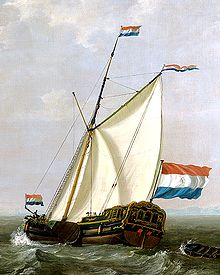
The term, yacht, originates from the Dutch word jacht (pl. jachten), which means "hunt", and originally referred to light, fast sailing vessels that the Dutch Republic navy used to pursue pirates and other transgressors around and into the shallow waters of the Low Countries.[2]
History
[edit]The history of pleasure boats begins with rowed craft in Pharaonic Egyptian times, and other vessels in the waters of Burma, India, Mindanao and Japan. Anglo-Saxon royal pleg-scips (play ships) of the 8th-century featured ornamented bows and sterns and had the capability of cooking on board.[10]
Sail
[edit]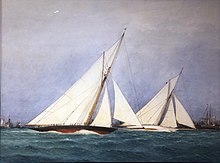
The history of sailing yachts begins in Europe in the beginning of the 1600s with the building of a pleasure vessel for the son of King James I of England. While other monarchs used naval ships for transportation and conquest, James I was the first English monarch to commission the construction of a yacht—for his son Henry, Prince of Wales in the early 1600s.[11] Pleasure vessels acquired the name yacht after the time of Charles II, who spent time exiled in Europe and visited the Netherlands, where a variety of jachten were already well developed as pleasure boats for the elite classes since the beginning of the 17th century. Upon his restoration to the English crown, Charles commissioned a series of royal yachts, which included at least one experimental catamaran. The first recorded yacht race between two vessels occurred in 1661, followed by the first open sailing competition in 1663 in English waters.[12]
Starting in 1739, England found itself in a series of wars—a period that saw a decline in yachting. In Ireland, however, the gentry enjoyed yachting and founded the first yacht club in Cork as the Cork Harbour Water Club in 1720. English yacht racing continued among the English gentry who founded England's oldest yacht club in 1775 to support a fleet at Cumberland. With maritime peace, starting in 1815, came a resurgence of interest in yachting. Boatbuilders, who had been making fast vessels both for smugglers and the government revenue cutters, turned their skills again to yachts.[12]
The fast yachts of the early 19th century were fore-and-aft luggers, schooners, and sloops. By the 1850s, yachts featured large sail areas, a narrow beam, and a deeper draft than was customary until then. Racing between yachts owned by wealthy patrons was common, with large wagers at stake. The America's Cup arose out of a contest between the yacht, America, and its English competitors. Both countries had rules by which to rate yachts, the English by tonnage and the American by length.[12]
In the late 19th century, yacht owners would base their choice of vessel upon preferred lifestyle and budget, which would determine the size and type of vessel, which would most likely be a fore-and aft, two-masted sailing vessel. A treatise on the subject, A Manual of Yacht and Boat Sailing, provided detailed information on selecting, equipping, sailing, seamanship, management of the paid crew, and racing such vessels. It included a brief section on steam yachts, the recirculating coil steam engine just having made such yachts efficient enough for leisure travel on the water.[13]
Power
[edit]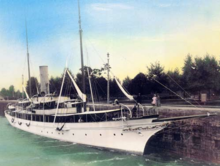

While sailing yachts continued to exist, the development of reliable power plants created a new category of pleasure craft. The power plants started with the steam engine and transitioned to the internal combustion engine. Whereas sailing yachts continued to be steered from the after portion of the vessel, power yachts adopted the bridge in a forward cabin structure that afforded better forward and sideways visibility.[12]
Steam
[edit]The history of steam yachts starts with large sailing yachts with a steam auxiliary engine. Early examples, driven with paddle wheels, had a railed platform from which the person conning the vessel could walk across the vessel above the main deck, the origin of the bridge. In the late 18th century, steam engines became more efficient, spars were removed and screw propellers became standard.[14] Steam yachts evolved with the development of the steam engine. Ultimately, engines employed pistons driven by steam within cylinders, connected to a crank shaft, which drove a propellor.[14]
Near the end of the 19th century, compound engines came into widespread use.[14] Compound engines exhausted steam into successively larger cylinders to accommodate the higher volumes at reduced pressures, giving improved efficiency. These stages were called expansions, with double- and triple-expansion engines being common, especially in shipping where efficiency was important to reduce the weight of coal carried.[15] Steam engines remained the dominant source of power until the early 20th century, when advances in the design of the steam turbine, electric motors and internal combustion engines gradually resulted in the replacement of reciprocating (piston) steam engines.[15][16]
Large steam yachts were luxurious; their staff included a captain, engineer, and stewards, as well as deck hands.[12]
Internal combustion
[edit]Nicolaus Otto and Gottlieb Daimler developed practical four-stroke gasoline engines, starting in 1876. Beginning in 1898 engines increased in horsepower from 25 horsepower (19 kW) to 500 brake horsepower (370 kW) by 1906. Some were destined for speedboats, other for motor yachts.[17] Diesel power plants for boats were demonstrated in 1903.[18] Diesels became a more prevalent type of power plant in the 20th century thanks to their low cost of operation and reliability.[17]
Classification
[edit]
The Recreational Craft Directive requires that all vessels sold in the European Union and United Kingdom satisfy one of four design categories, based on the wind force and seas that they are designed to encounter:[19]
- A yachts are fit for conditions that exceed wind force 8—40 knots (21 m/s)—and 13-foot (4 m) maximum wave heights, encountered in ocean passages and extended voyages.
- B yachts are fit for conditions that are less than wind force 8—40 knots (21 m/s)—and 13-foot (4 m) maximum wave heights, encountered in ocean passages and extended voyages.
- C yachts are fit for wind force 6—27 knots (14 m/s)—and 6.6-foot (2 m) maximum wave heights, encountered in exposed coastal waters, bays inlets, lakes and rivers.
- D yachts are fit for wind force 4—16 knots (8.2 m/s)—and 1.6-foot (0.5 m) maximum wave heights, encountered in sheltered coastal waters, bays inlets, lakes and rivers.
The Large Commercial Yacht Code (LY2) of Great Britain and its dominions defines a large yacht as one that is 24 metres (79 ft) or more at the waterline and is in commercial use for sport or pleasure, while not carrying cargo or more than 12 passengers and carrying a professional crew. The code regulates the equipping of such vessels, both at sea and in port—including such matters as crew duty times and the presence of a helicopter on board. The code has different levels of standard for vessels above and below 500 gross tons.[20] Such yachts may be considered superyachts and are more commonly at 40 metres (130 ft) or more in length.[21] Other countries have standards similar to LY2.[6]
Whereas commercial large yachts may carry no more than 12 passengers, private yachts are solely for the pleasure of the owner and guests do not carry the passenger restriction. Yachts may be identified by flag—the country under which a yacht is registered.[6] An industry publication categorizes superyachts by size,[22] by speed,[23] as "explorer" yachts,[24] as sailing yachts,[25] and classic yachts.[26]
Construction
[edit]Originally, all yachts were made of wood, using a wooden keel and ribs, clad with planks. These materials were supplanted with iron or steel in steam yachts.[12] In the 1960s fiberglass became a prevalent material. These materials and others continue in use.[27] Whereas yachts of 79 feet (24 m) and below may be constructed of fiberglass, larger yachts are more likely to be constructed of steel, aluminum or composite fiber-reinforced plastic.[28]
- Wood construction, using conventional planks over ribs continues. Hard-chined boats made with plywood is an infrequent technique, whereas yachts made with the WEST system—plies of wood strips, soaked in epoxy and applied over the boat frame—provide a durable, lightweight and robust hull.
- Metal hulls from steel or aluminum offer the opportunity for welding components to a completely watertight hull. Both metals are vulnerable to damage due to electrolysis. Steel is easy to repair in boatyards around the world, whereas aluminum is a much lighter material.
- Fiberglass construction is best suited for mass-produced yachts, using a mold and is therefore the most prevalent material. Fiberglass skins comprise plies of roving (glass fabric) and matting, soaked in resin for the hull. Decks typically have a core of balsa or PVC foam between layers of glass mat. Both elements of construction are vulnerable to intrusion of water and the development of blisters below the waterline.[29]
Accommodations
[edit]
Depending on size, a cruising yacht is likely to have at least two cabins, a main salon and a forward stateroom. In smaller yachts, the salon is likely to have convertible berths for its crew or passengers. Typically the salon includes a dining area, which may have a folding, built-in table. The salon is typically contiguous to the galley. A cruising yacht is likely to have a head (bathroom) with a marine toilet that discharges waste into a holding tank. Larger yachts may have additional staterooms and heads. There is typically a navigation station that allows planning the route.[30][31]
Systems
[edit]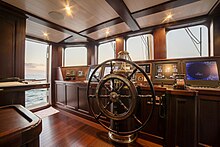
Onboard systems include:[31]
- Electrical power, provided by batteries recharged by a motor-driven alternator (sail) or by a generator set (motor)
- Water, stored in on-board tanks, refilled on shore or replenished with a desalination water maker
- Sanitation, provided by toilets using seawater and discharged into holding tanks.
- Refrigeration by ice or an engine-driven mechanical system.
Modern yachts employ a suite of electronics for communication, measurement of surroundings, and navigation.[32]
- Communications equipment includes radios in a variety of bandwidths, specifically for maritime use.
- Instrumentation also provides information on depth of water under the vessel (depth sounder), windspeed (anemometer), and directional orientation (compass).
- Navigation electronics include units that identify a vessel's location (e.g. GPS) and display the vessel's location (chartplotter) and other vessels and nearby shore (radar).
Sailing yachts
[edit]
Sailing yachts for cruising versus racing embody different tradeoffs between comfort and performance. Cruising yachts emphasize comfort over performance. Racing yachts are designed to compete against others in their class, while providing adequate comfort to their crews.
Cruising
[edit]Cruising yachts may be designed for near-shore use or for passage-making. They may also be raced, but they are designed and built with the comfort and amenities necessary for overnight voyages. Qualities considered in cruising yachts include: performance, comfort under way, ease of handling, stability, living comfort, durability, ease of maintenance, affordability of ownership.[33]
Categories
[edit]Cruising sailboats share the common attribute of providing overnight accommodations. They may be classified as small (easy to haul behind a trailer),[34] near-shore[2] and off-shore.[35] Multihull sailing yachts are a category, apart.[36]
- Small yachts are typically shorter than 33 feet (10 m) length overall.[36] Trailer sailers that are readily towed by a car are generally shorter than 25 feet (7.6 m) length overall and weigh less than 5,000 pounds (2,300 kg).[34]
- Near-shore yachts typically range in size from 33–45 feet (10–14 m) length overall.[5]
- Offshore yachts typically exceed 45 feet (14 m) length overall.[36]
Design
[edit]

Design considerations for a cruising yacht include seaworthiness, performance, sea kindliness, and cost of construction, as follows:[33]
- Seaworthiness addresses the integrity of the vessel and its ability to stay afloat and shelter its crew in the conditions encountered.
- Performance hinges on a number of factors, including the waterline length (longer means faster), drag in the water (narrower hull with smooth appendages), hull shape, and sail shape and area.
- Sea kindliness is an indicator of steering ease, directional stability and quelling of motion induced by wind and waves.
Multihulls offer tradeoffs as cruising sailboats, compared with monohulls. They may be catamarans or trimarans. They rely on form stability—having separate hulls far apart—for their resistance to capsize.[33] Their advantages include greater: stability, speed, (for catamarans) living space, and shallower draft. Their drawbacks include: greater expenses, greater windage, more difficult tacking under sail, less load capacity, and more maneuvering room required because of their broad beam. They come with a variety of sleeping accommodations and (for catamarans) bridge-deck configurations.[37]
Rigs
[edit]Gaff rigs have been uncommon in the construction of cruising boats, since the mid 20th century. More common rigs are Bermuda, fractional, cutter, and ketch. Occasionally employed rigs since then have been the yawl, schooner, wishbone, catboat.[27]
Gear
[edit]Sailboats employ standing rigging to support the rig, running rigging to raise and adjust sails, cleats to secure lines, winches to work the sheets, and more than one anchor to secure the boat in harbor. A cruising yacht's deck usually has safety line to protect the crew from falling overboard and a bow pulpit to facilitate handling the jib and the anchor. In temperate climates, the cockpit may have a canvas windshield with see-through panels, called a "dodger". Steering may be either by tiller or wheel.[27]
Engine
[edit]Cruising yachts have an auxiliary propulsion power unit to supplement the use of sails. Such power is inboard on the vessel and diesel, except for the smallest cruising boats, which may have an outboard gasoline motor. A 31-foot (9.4 m) sailboat might have a 13-horsepower (9.7 kW) engine,[38] whereas a 55-foot (17 m) sailboat might have a 110-horsepower (82 kW) engine.[39]
Racing
[edit]
Racing yachts emphasize performance over comfort. World Sailing recognizes eleven classes of racing yacht.[40]
Design features
[edit]High-performance rigs provide aerodynamic efficiency and hydrodynamically efficient hulls minimize drag through the water and sideways motion.
Racing yachts have a wide selection of weights and shapes of sail to accommodate different wind strengths and points of sail. A suite of sails on a racing yachts would include several weights of jib and spinnaker, plus a specialized storm jib and trysail (in place of the mainsail). Performance yachts are likely to have full-battened kevlar or carbon-fiber mainsails.[31]
Underwater foils can become more specialized, starting with a higher-aspect ratio fin keel with hydrodynamically efficient bulbs for ballast.[41] On some racing yachts, a canting keel shifts angle from side to side to promote sailing with less heeling angle (sideway tilt), while other underwater foils take care of leeway (sideways motion).[42][31]
Motor yachts
[edit]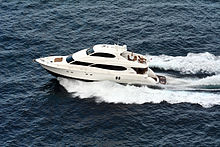


Motor yachts range in length from 33–130 feet (10–40 m) before they are considered super-yachts or mega-yachts, which are 130 feet (40 m) and longer. They also vary by use, by style, and by hull type. As of April 2020 a 600-foot (180 m) yacht, REV Ocean, was under construction,[43] which when launched would replace the 590-foot (180 m) Azzam as the longest superyacht.[1] As superyachts have grown size, the distinction between a yacht and a ship (perhaps converted for personal use) has become unclear. A proposed definition for calling a vessel a yacht rather than a ship would if it was constructed solely for personal use and has a combined occupancy of less than 100, including crew.
Classification
[edit]The United States Coast Guard classifies motorboats—any vessel less than 65 feet (20 m), propelled by machinery—in four classes by length:[44]
- Class A: motorboats less than 16 feet (4.9 m)
- Class 1: motorboats 16–26 feet (4.9–7.9 m)
- Class 2: motorboats 26–40 feet (7.9–12.2 m)
- Class 3: motorboats 40–65 feet (12–20 m)
Style
[edit]A motor yacht's style can both be functional and evoke an aesthetic—trending towards the modern or the traditional. Among the styles, mentioned in the literature, are:[45]
- Cruiser – A cruiser has a displacement hull for economical, long-distance passage-making.
- Sports cruiser – A sports cruiser has a semi-displacement or planing hull for fast trips.
- Sports fisherman – A sports fisherman has a semi-displacement or planing hull for fast trips and carries gear for recreational catching of large fish.
- Expedition –An expedition yacht has a displacement hull for economical, long-distance passage-making to remote destinations. These are also called explorer yachts.[24]
- Lobster – A lobster yacht is styled like a Maine lobster boat and has a semi-displacement or planing hull for fast trips.
- Trawler– A trawler has conservative, traditional styling and has a displacement hull for economical, medium-distance passage-making.
Hulls
[edit]There are three basic types of motor yacht hull: full-displacement, semi-displacement, and planing, which have progressively higher cruise speeds and hourly fuel consumption with increased engine power:[46]
- Full-displacement hulls move the water up and out of the way of the vessel, making a wave. They are limited in speed by the square root of the waterline length multiplied by a factor, depending on the units used. Added horsepower cannot increase the maximum speed, only the size of the waves produced.
- Semi-displacement hulls allow speeds that are faster than the hull speed of a displacement vessel because they rise somewhat out of the water and create smaller waves. They also provide greater comfort than planing hulls.
- Planing hulls require sufficient power for the boat to slide up onto the surface, which avoids the need to use power to lift water out of the way of the vessel. Such vessels have flat surfaces on the undersides.
A typical semi-displacement yacht has a wedge-shaped bow, which promotes penetrating waves, that transitions to flatter, wider surfaces aft, which promotes lifting the vessel out of the water—the "deep vee" hull, designed by Ray Hunt, found in approximately 75% of modern power boats.[47]
Cruising motor yachts are available in a range of styles as two-engine catamarans, ranging in length from 40–150 feet (12–46 m) with top speeds ranging from 20–60 knots (37–111 km/h).[48]
Engines
[edit]
Motor yachts typically have one or more diesel engines. Gasoline-powered motors and engines are the provenance of outboard motors and racing boats, due to their power-to-weight ratios.[45] Two engines add expense, but provide reliability and maneuverability over a single engine.[49]
Motor yachts in the 42-foot (13 m) range might have the following hull, horsepower, cruise speed, and hourly fuel consumption characteristics:
- Full-displacement hull – two 135-horsepower (101 kW) diesels to cruise at 9 knots (17 km/h), consuming 5 US gallons per hour (19 L/h).[50]
- Semi-displacement hull – two 350-horsepower (260 kW) diesels to cruise at 17 knots (31 km/h), consuming 12 US gallons per hour (45 L/h).[51][52]
- Planing hull – two 400-horsepower (300 kW) diesels to cruise at 30 knots (56 km/h), consuming 24 US gallons per hour (90 L/h).[53][50]
Superyachts may employ multiple 9,000-horsepower (6,700 kW) diesels[54] or a combination of diesels and gas turbines with a combined 47,000 horsepower (35,000 kW).[55]
See also
[edit]- World Sailing
- List of keelboat classes designed before 1970
- List of large sailing yachts
- List of motor yachts by length
- List of sailing boat types
- List of sailboat designers and manufacturers
- Model yachting
- Superyacht
- Yacht broker
- Yacht charter
- Yacht racing
- Yacht transport
- Yacht tender
- Yacht support vessel
- Yachting
References
[edit]- ^ a b c d Kavin, Kim (June 4, 2018). "When is a Boat Also a Yacht? - boats.com". www.boats.com. Retrieved 2020-04-19.
- ^ a b c "Definition of YACHT". www.merriam-webster.com. Retrieved 2018-04-15.
any of various recreational watercraft: such as a) a sailboat used for racing b) a large usually motor-driven craft used for pleasure cruising
- ^ "YACHT | definition in the Cambridge English Dictionary". dictionary.cambridge.org. Retrieved 2020-04-19.
a boat with sails and sometimes an engine, used for either racing or traveling on for pleasure
- ^ "Yacht definition and meaning | Collins English Dictionary". www.collinsdictionary.com. Retrieved 2020-04-19.
a large boat with sails or a motor, used for racing or pleasure trips
- ^ a b c Coles, Richard; Lorenzon, Filippo (2013-07-31). Law of Yachts & Yachting. CRC Press. ISBN 9781317995791.
- ^ a b c Moretti, Paolo (January 21, 2015). "Yacht classification definitions". Boat International. Retrieved 2019-04-19.
- ^ a b Perry, Julie (August 2013). Insiders' guide to becoming a yacht stewardess: confessions from my years afloat with the rich and famous (Second ed.). New York. ISBN 978-1-61448-786-9. OCLC 859781233.
{{cite book}}: CS1 maint: location missing publisher (link) - ^ Watson, G. L. (2013). The Evolution Of Modern Yacht Racing In 1894. Read Books Ltd. ISBN 978-1447484196.
- ^ Perry, Julie (August 2013). Insiders' guide to becoming a yacht stewardess : confessions from my years afloat with the rich and famous (Second ed.). New York. ISBN 978-1-61448-786-9. OCLC 859781233.
{{cite book}}: CS1 maint: location missing publisher (link) - ^ Folkard, Henry Coleman (1906). The Sailing Boat: A Treatise on Sailing Boats and Small Yachts, Their Varieties of Type, Sails, Rig, Etc. London: Chapman and Hall.
- ^ Major, Alan P. (2011). Royal yachts. Stroud: Amberley. ISBN 978-1-4456-1107-5. OCLC 1100700087.
- ^ a b c d e f Herreshoff, L. Francis (2007). The Golden Age of Yachting. Sheridan House, Inc. pp. 19–25. ISBN 978-1-57409-251-6.
- ^ Kemp, Dixon (1882). A Manual of Yacht and Boat Sailing. London: Horace Cox.
- ^ a b c Evers, Henry (1873). Steam and the Steam Engine: Land and Marine. Putnam.
- ^ a b Hunter, Louis C. (1985). A History of Industrial Power in the United States, 1730–1930. Vol. 2: Steam Power. Charlottesville: University Press of Virginia.
- ^ Wiser, Wendell H. (2000). Energy resources: occurrence, production, conversion, use. Birkhäuser. p. 190. ISBN 978-0-387-98744-6.
- ^ a b Day, Thomas Fleming (1916). The Rudder. Fawcett Publications. pp. 299–303.
- ^ Sass, Friedrich (1962). Geschichte des deutschen Verbrennungsmotorenbaus von 1860 bis 1918 (in German). Berlin/Heidelberg: Springer. p. 532. ISBN 978-3-662-11843-6.
- ^ Association, Royal Yachting (2018-12-20). RYA Stability & Buoyancy (E-G23). Royal Yachting Association.
- ^ Maritime and Coastguard Agency (September 2007). The Large Commercial Yacht Code (LY2) (PDF). Southampton: Department of Transport.
- ^ Nineham, Laura (August 22, 2016). "Megayachts explained". Boat International. Retrieved 2019-04-21.
- ^ "Top 200 largest yachts". Boat International. December 13, 2018. Retrieved 2019-04-21.
- ^ "Top 20 Fastest yachts". Boat International. 2018. Retrieved 2019-04-21.
- ^ a b "Top 20 largest Explorer Yachts". Boat International. 2018. Retrieved 2019-04-21.
- ^ "Top 50 Largest Sailing Yachts". Boat International. 2018. Retrieved 2019-04-21.
- ^ "Top 20 Classic Yachts". Boat International. 2018. Retrieved 2019-04-21.
- ^ a b c Howard, Jim; Doane, Charles J. (2000). Handbook of Offshore Cruising: The Dream and Reality of Modern Ocean Cruising. Sheridan House, Inc. ISBN 978-1-57409-093-2.
- ^ Coles, Richard; Lorenzon, Filippo (2013-07-31). Law of Yachts & Yachting. CRC Press. pp. 3–4. ISBN 9781317995791.
- ^ Caswell, Chris (August 4, 2000). "Fiberglass Blisters". www.boats.com. Retrieved 2021-12-26.
- ^ Doane, Charles J. (2010). The modern cruising sailboat : a complete guide to its design, construction, and outfitting. Camden, Me.: International Marine. ISBN 978-0-07-163700-8. OCLC 551161085.
- ^ a b c d DK (2011-12-19). The Complete Sailing Manual, Third Edition. Penguin. ISBN 978-0-7566-9760-0.
- ^ Payne, John C., 1954- (2006). Understanding boat electronics. Dobbs Ferry, NY: Sheridan House. ISBN 1-57409-228-6. OCLC 63125961.
{{cite book}}: CS1 maint: multiple names: authors list (link) CS1 maint: numeric names: authors list (link) - ^ a b c Association, Royal Yachting; McClary, Dick (2019-06-04). RYA Offshore Sailing (E-G87). Royal Yachting Association.
- ^ a b Henkel, Steve (2010-01-15). The Sailor's Book of Small Cruising Sailboats: Reviews and Comparisons of 360 Boats Under 26 Feet. McGraw Hill Professional. ISBN 978-0-07-173694-7.
- ^ Committee, Cruising Club of America Technical (1987). Desirable and Undesirable Characteristics of Offshore Yachts. W. W. Norton & Company. ISBN 978-0-393-03311-3.
- ^ a b c Judges panel (March 1997). Boats of the Year. pp. 90–100.
{{cite book}}:|work=ignored (help) - ^ Tarjan, Gregor. (2008). Catamarans : the complete guide for cruising sailors. Camden, Me.: International Marine. ISBN 978-0-07-159622-0. OCLC 233534126.
- ^ Liscio, David (May 5, 2014). "Hunter 31". Sailing Magazine. Retrieved 2020-04-22.
- ^ "Swan 54 Specification". Nautor. Retrieved 2020-04-22.
- ^ Staff. "Sailboat Classes & Equipment Index". sailing.org. Retrieved 2020-04-26.
- ^ Killing, Steve; Hunter, Douglas (1998). Yacht Design Explained: A Sailor's Guide to the Principles and Practice of Design. W. W. Norton & Company. ISBN 978-0-393-04646-5.
- ^ Slooff, J. W. (2015-04-25). The Aero- and Hydromechanics of Keel Yachts. Springer. ISBN 978-3-319-13275-4.
- ^ Kirsch, Noah. "The Ultimate Quarantine: This Oil Billionaire Is Building The World's Largest Superyacht – And Claims It Will Help Save The Oceans". Forbes. Retrieved 2020-11-03.
- ^ United States Coast Guard (1966). Official U.S. Coast Guard Recreational Boating Guide. Washington, DC: U.S. Government Printing Office. p. 6.
- ^ a b Pike, Dag (2019-10-31). Powerboat Design and Performance: Expert insight into developments past and future. Bloomsbury Publishing. ISBN 978-1-4729-6539-4.
- ^ Thiel, Richard (May 2013). "Understanding Hull Design". Power & Motoryacht. Retrieved 2020-04-23.
- ^ Prince, Bill (June 2019). "The Basics of Hull Design Explained". Power & Motoryacht. Retrieved 2020-04-23.
- ^ Smith, Alex (February 12, 2018). "Best multihull powerboats - boats.com". Boats.com. Retrieved 2020-04-24.
- ^ Inboard Boats. Vol. 7. Boating Magazine. February 1960.
- ^ a b Knauth, Steve (March 29, 2010). "Grand Banks 42: Used Boat Review - boats.com". Boats.com. Retrieved 2020-04-24.
- ^ Azimut Yachts. "Technical characteristics: Azimut Magellano 43". www.azimutyachts.com. Retrieved 2020-04-24.
- ^ Elissa. "Azimut Magellano 43". www.canadianyachting.ca. Retrieved 2020-04-24.
- ^ Azimut Yachts. "Technical characteristics: Azimut Atlantis 43". www.azimutyachts.com. Retrieved 2020-04-24.
- ^ "Exclusive: Mariotti superyacht Fulk Al Salamah delivered". SuperYacht Times.
- ^ "Nauta Yachts comments on their design for superyacht Azzam". SuperYacht Times. 9 April 2013. Retrieved 10 April 2013.
